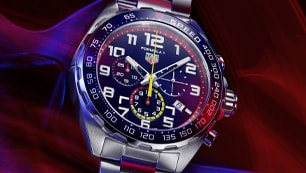HEUER CAMARO
The Camaro is a special chronograph from the 1960s. Offered only as a manual-winding model, the watch had a relatively short run in the Heuer catalogue, but during this time it appeared in a broad variety of models. The cushion shaped case of the Camaro offered a distinctive style, and was available in stainless steel, as well as 18 karat gold and gold-plated models. Dials, hands, and movements were very refined, as used on the Autavia, Carrera and Monaco models, but many enthusiasts enjoy the smaller size of the Camaro. Yes, Jack Heuer named the Camaro after one of the dominant American muscle cars of the 1960s, and the Camaro managed to show its muscle in a retrained, elegant style.

Introduced in 1968, the Camaro chronograph occupies a unique position in the vintage Heuer catalogue. While the Autavia, introduced in 1962, and the Carrera, introduced in 1963, made the transition in 1969 from being powered by manual-winding movements to being powered by automatic movements, the Camaro continued to use only manual movements. While the automatic Autavias and Carreras had a resurgence in the 1970s, along with the Monaco and other automatic chronographs, the Camaro had a shorter lifespan, disappearing from Heuer’s catalogs within four years after its introduction. Still, the Camaro has a dedicated following among vintage Heuer enthusiasts, offering a style that transitions well between the 1960s and 1970s in a case that many find easy to wear.

The “Camaro” Name
A Swiss watch named after an American muscle car? Jack Heuer is unapologetic in acknowledging that he named the watch after the Chevrolet Camaro because he was seeking to strengthen Heuer’s position in the US market by aligning the brand with US motor racing. The Chevrolet Camaro was very popular in the late 1960s, as the natural rival to the Ford Mustang, and its position as the pace car at the Indianapolis 500 in 1967 and 1969 helped convince Jack that the name was a good fit.
OVERVIEW OF THE CAMARO - THE MOVEMENTS
The key to understanding the Camaro is to start by looking at the various movements that were used in the chronograph. There were many different Camaro models, but it all becomes more manageable when we realize that there are only three families of movement offered in the Camaro, each supplied to Heuer by Valjoux.
VALJOUX 72
The Valjoux 72 is a three-register, manual-wind chronograph movement, which traces its origins back to the 1930s. A relatively small movement (13 ligne), Heuer used the Valjoux 72 movement in both the Autavia and the Carrera.
The Valjoux 72 models offer no date display and has the following dial layout:
- 3 o’clock: 30-minute chronograph register
- 6 o’clock: 12-hour chronograph register
- 9 o’clock: running seconds
VALJOUX 92
The Valjoux 92 followed the success of the Valjoux 72 in the 1950s and is also a 13-ligne movement, but with only two registers:
- 3 o’clock: 45-minute chronograph register
- 9 o’clock: running seconds
VALJOUX 773X FAMILY
The Valjoux 7730 is a manual-wind two-register movement (14 ligne) with 30-minute chronograph capacity.
Valjoux upgraded the 7730 movement in 1968, calling the revised calibre the Valjoux 7733, which serves as a base for several modified versions, including:
- 7733- base 2-register movement
- 7734- as above, but with date
- 7736- as per the 7733, but with the addition of a 12-hour register
The 773X family is larger than the Valjoux 72, both in diameter (31.3mm vs. 29.5mm) and height (7.4mm vs. 6.25mm). While a three-register Camaro chronograph may be powered by either the Valjoux 72 or the Valjoux 7736, the case housing the 7736 will be thicker (and the pushers will also be in different positions).
THE CAMARO DESIGN
In many ways, the Camaro is the sister-watch to the Heuer Carrera, with both models sharing similar dial, hands and movements. The difference is of course in the case, where the Camaro features a 37mm cushion-shape case, while the Carreras of the 1960s used 35.3 millimeter cases. The Camaro cases are beautifully finished, with a range of different surface textures: the starburst pattern on top of the case contrasts with the polished sides. The Camaro features a plexi crystal which sits proud of the case and has a soft curve.
The dials are beautifully refined, the 7220S has a starburst dial, applied hour-markers and indented registers, which feature an azurage pattern in the centre. Some model variants have a single, thick hour marker at 12 o’clock, but most have a double marker.
There are two types of pusher design on the Camaro -- early models feature smooth pushers, while later watches gained the fluted pushers, as used on many of Heuer’s automatic chronographs.

THE CAMARO RANGE
There are three lines to the Camaro family: the Camaro 12 (three registers with 12-hour counter), Camaro 30 (two register with 30 minute counter) and Camaro 45 (two register with 45 minute counter).
HEUER CAMARO 12
KEY REFERENCES
- Camaro 7220 with Valjoux 72 – early stainless steel case
- Camaro 7228 with Valjoux 72 – 18 karat gold case
- Camaro 73643 with Valjoux 7736 – stainless steel case
- HEUER CAMARO 30
KEY REFERENCES
- 73345- Gold-plated Case with Valjoux 7733; no date
- 73445- Gold-plated case with Valjoux 7734; date
- 7843- Stainless steel with Valjoux 7732; date
- 73443- Stainless steel with Valjoux 7734; date
- 7743- Stainless steel with Valjoux 7730; no date
- 73343- Stainless steel with Valjoux 7733; no date
- HEUER CAMARO 45
KEY REFERENCES
- Camaro 9220 -- Stainless steel case with Valjoux 92; no date














